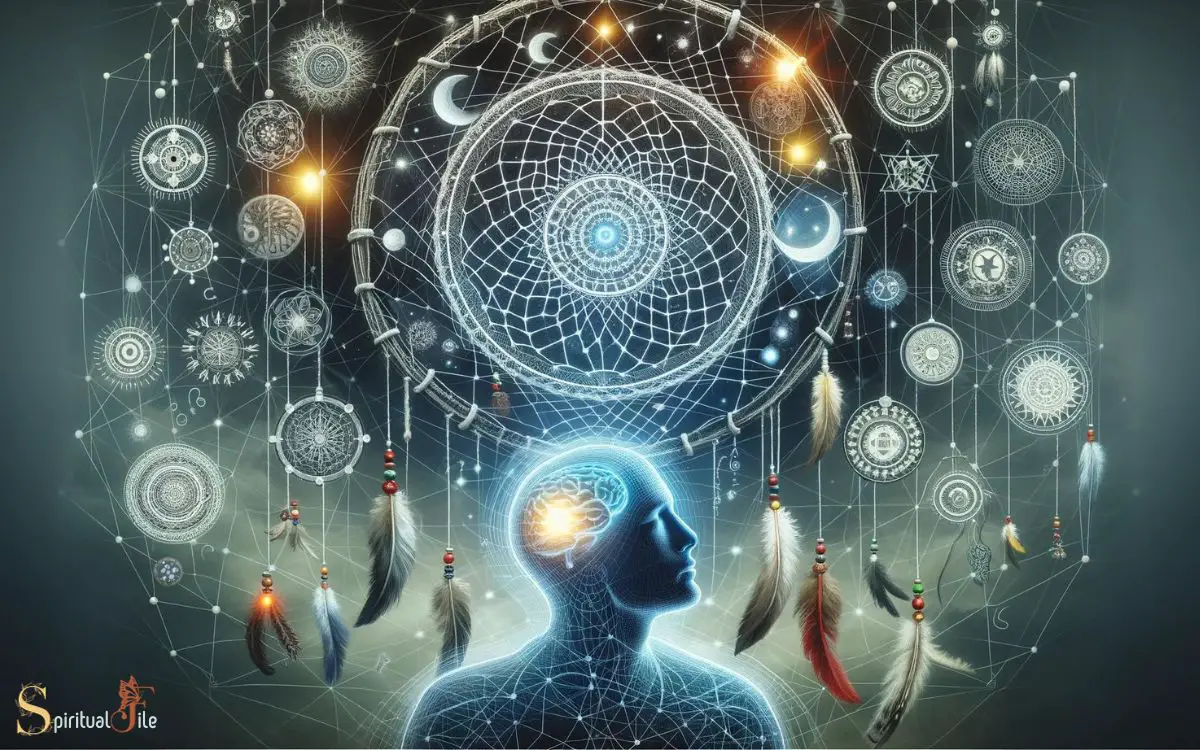Spiritual Dream Vs Spiritual Vision: Guidance!
Spiritual dreams and spiritual visions are both significant ways through which individuals may receive divine messages and guidance. A spiritual dream occurs during sleep and often involves symbolic scenarios that require interpretation.
In contrast, a spiritual vision is a waking experience where one sees or senses something with a deep spiritual significance, often with a clearer, more direct message.
Spiritual dreams typically happen when one is in the subconscious state of sleep. They can be filled with metaphorical imagery and can take some reflection and interpretation to understand the underlying spiritual message.
For example, dreaming of flying might symbolize a desire for freedom or the need to look at something from a higher perspective.
Spiritual visions, on the other hand, occur while one is awake and are usually more straightforward. Visions can be a clear sighting of an entity, a vivid scene played before one’s eyes, or an intense feeling of presence.
They are often experienced during meditation, prayer, or moments of intense focus and can be considered more immediate and impactful than dreams.
Differences between Spiritual Dreams and Visions:
– Occurrence: Dreams during sleep, visions while awake.
– Clarity: Dreams are often symbolic, visions are more direct.
– Interpretation: Dreams may require analysis, visions are typically understood immediately.
Understanding the distinction between spiritual dreams and visions can empower individuals to better interpret and integrate the profound messages they receive into their spiritual journey.

Key Takeaway
5 Aspects: Spiritual Dream Vs Spiritual Vision
| Aspect | Spiritual Dream | Spiritual Vision |
|---|---|---|
| Nature | Subconscious experiences | Inspired, conscious insight |
| Source | Dreams during sleep | Wakeful, intentional |
| Clarity | Often symbolic and vague | Clear, purposeful |
| Interpretation | Subjective and varied | Generally well-defined |
| Purpose | Personal exploration | Guiding life’s direction |
Defining Spiritual Dreams

Defining spiritual dreams involves interpreting symbolic imagery and messages received during sleep or altered states of consciousness.
These dreams often carry profound meanings and guidance for the dreamer. They can be vivid, emotionally intense, and filled with symbols that have personal or universal significance.
Spiritual dreams are believed to offer insights into one’s spiritual path, inner conflicts, or future events. Understanding and deciphering these dreams can provide individuals with valuable spiritual and psychological insights, leading to personal growth and self-discovery.
By paying attention to the details, emotions, and symbols within the dream, individuals can unlock the hidden messages and wisdom it holds.
Now, let’s delve into the subsequent section about understanding spiritual visions, which offer a different form of spiritual insight.
Understanding Spiritual Visions

The interpretation of spiritual visions involves perceiving and discerning visual messages and insights often experienced during wakefulness or altered states of consciousness. These visions are believed to offer guidance, revelations, or warnings.
Understanding spiritual visions requires openness, mindfulness, and a deep connection with one’s inner self and the divine.
It’s essential to approach these visions with humility and a willingness to seek the underlying meanings they convey. Spiritual visions can manifest in various forms, such as symbols, scenes, or encounters with spiritual beings.
The process of understanding spiritual visions often involves reflection, meditation, and seeking wisdom from spiritual guides or mentors.
It’s important to note that the interpretation of spiritual visions is highly personal and may vary based on individual beliefs and experiences.
Interpreting Messages in Dreams

Interpreting messages in dreams involves analyzing the symbolic content and underlying meanings within one’s subconscious experiences. Dreams often communicate in metaphorical and symbolic language, requiring careful interpretation to discern their significance.
The key to interpreting messages in dreams lies in understanding the personal associations and emotions evoked by the dream symbols. It is essential to consider the context of the dream, the dreamer’s current life circumstances, and their emotional state.
Additionally, recurring symbols or themes in dreams may highlight unresolved issues or unmet needs. Dream journals can aid in recognizing patterns and gaining insight into the recurring messages of dreams.
Consulting with a spiritual advisor or therapist can also offer valuable perspectives on decoding the messages within dreams, leading to a deeper understanding of oneself and the spiritual guidance being offered.
Discerning Guidance in Visions

Discerning guidance in visions involves recognizing the symbolic and meaningful elements within the visual experiences, requiring a deep understanding of their personal relevance and emotional resonance.
When discerning guidance in visions, consider the following:
- Context: Reflect on the circumstances surrounding the vision.
- Emotional Response: Pay attention to the feelings evoked by the vision.
- Recurring Symbols: Take note of any recurring symbols or themes.
- Personal Relevance: Consider how the vision relates to your personal experiences and beliefs.
- External Input: Seek guidance from mentors or spiritual leaders for interpretation.
Understanding these aspects can aid in discerning the guidance offered by spiritual visions. It is essential to acknowledge the depth of these visual experiences in order to interpret them accurately.
Transitioning into the subsequent section, it’s important to explore the differences in clarity and detail.
Differences in Clarity and Detail

When considering spiritual experiences, the differences in clarity and detail between dreams and visions are significant.
Clarity in visions often provides a vivid and distinct impression, whereas dreams may offer a more symbolic or abstract representation.
Understanding the perception and depth of these experiences is essential for interpreting divine communication.
Clarity Vs. Detail
Spiritual visions often present with a higher level of clarity compared to spiritual dreams. In a vision, the images and messages are often more vivid and easily understood, whereas dreams can be more abstract and open to interpretation.
The differences in clarity between the two can be explained as follows:
- Directness: Visions are often more direct in their communication, while dreams may be more symbolic.
- Realism: Visions may appear more realistic, like watching a movie, whereas dreams can feel more surreal and fragmented.
- Understanding: Visions are often easier to understand immediately, while dreams may require more reflection and interpretation.
- Impact: Visions can have a more profound impact on the individual, often leaving a lasting impression, while dreams may fade more quickly.
- Guidance: Visions may provide clearer guidance, while dreams may require more effort to discern their meaning.
Transitioning into the subsequent section about ‘perception and depth’, the differences in clarity and detail also affect the way individuals perceive and interpret spiritual experiences.
Perception and Depth
Frequently, the differences in clarity and detail between spiritual visions and dreams significantly impact individuals’ perception and depth of spiritual experiences.
Spiritual visions often have a heightened clarity and vividness, providing a profound sense of reality and depth.
This heightened clarity allows individuals to perceive intricate details, vivid colors, and symbolic imagery with an extraordinary level of precision, leading to a deeper understanding of the spiritual message being conveyed.
On the other hand, spiritual dreams may offer a more symbolic and abstract representation of spiritual insights, often lacking the vividness and detailed clarity of visions.
Consequently, the depth of understanding derived from spiritual dreams may require more interpretation and reflection to grasp the intended spiritual significance.
Understanding these differences can help individuals discern and interpret their spiritual experiences more effectively.
Interpreting Divine Communication
The heightened clarity and vividness of spiritual visions enable individuals to discern intricate details and vivid colors, thus enhancing their ability to interpret divine communication with precision and depth.
- Depth of Revelation: Visions often provide a deeper understanding of spiritual truths.
- Symbolic Representation: Visions may use symbols to convey complex messages.
- Personal Relevance: Visions can be tailored to the individual’s spiritual journey.
- Emotional Impact: The intense sensory experience of visions can evoke strong emotions.
- Prophetic Insight: Visions may offer glimpses into future events or spiritual realities.
This heightened clarity and detail in spiritual visions allows for a richer and more nuanced interpretation of divine communication, providing individuals with deeper insights and understanding.
Next, let’s explore the significance of spiritual dreams in religious texts.
Spiritual Dreams in Religious Texts

Religious texts are replete with instances of spiritual dreams, often laden with symbolism and significance.
These dreams are recorded and interpreted within the religious texts, shedding light on their meanings and implications.
Understanding the role and interpretation of spiritual dreams in religious texts provides valuable insight into the spiritual and cultural significance of these dreams.
Symbolism in Religious Dreams
In examining the symbolism found in religious dreams, one can discern profound spiritual insights embedded within various religious texts. The symbolism in religious dreams often carries significant meanings, providing spiritual guidance and understanding for believers.
Here are some reasons why symbolism in religious dreams is essential:
- Universal Language: Symbolism in religious dreams transcends cultural and linguistic barriers, conveying spiritual truths that resonate across diverse communities.
- Depth of Meaning: Symbols in religious dreams often hold deeper spiritual significance, offering multi-layered interpretations that enrich the understanding of believers.
- Divine Communication: Symbolism in religious dreams is considered a mode of divine communication, guiding individuals through symbolic messages from a higher power.
- Personal Relevance: The symbolism in religious dreams can be deeply personal, addressing individual spiritual journeys and offering personalized guidance.
- Historical Context: Symbols in religious dreams often carry historical significance, connecting believers to the rich tapestry of their faith’s traditions and teachings.
This profound symbolism in religious dreams underscores the importance of interpretation in religious texts.
Interpretation in Religious Texts
Interpreting spiritual dreams found in religious texts requires a nuanced understanding of symbolism and contextual significance. In religious texts, dreams often carry deep spiritual meanings that are open to interpretation.
For instance, in the Bible, Joseph’s dream of sheaves of wheat bowing down to his sheaf was interpreted as a prophecy of his future leadership.
Similarly, in the Quran, Prophet Ibrahim’s dream of sacrificing his son Isma’il is seen as a test of faith and submission to God. Understanding the historical and cultural context of these dreams is essential for accurate interpretation.
The symbolic elements, characters, and actions in the dreams often hold significant spiritual and moral implications, which can guide believers in understanding the divine will.
Transitioning into the subsequent section, let’s now explore the significance of spiritual visions in divine encounters.
Spiritual Visions in Divine Encounters

The experience of spiritual visions in divine encounters reveals profound insights into the nature of the soul’s journey. In these encounters, individuals often receive vivid and symbolic visions that carry deep spiritual significance.
These visions can provide guidance, comfort, and enlightenment, offering a glimpse into the divine realm and the mysteries of existence.
The following insights into spiritual visions in divine encounters shed light on their significance:
- Symbolic Representation: Visions often present symbolic imagery that conveys profound spiritual truths.
- Personal Relevance: Visions are often tailored to the individual, addressing specific concerns or providing personal messages.
- Transcendent Realms: Visions may offer glimpses into higher spiritual dimensions beyond ordinary human perception.
- Divine Communication: Visions can serve as a means of direct communication from the divine realm to the individual.
- Spiritual Guidance: Visions may offer guidance and direction for navigating life’s challenges and spiritual growth.
What is the Difference Between Spiritual Dreams and Spiritual Warnings?
Spiritual dreams are peaceful and inspiring, while ear ringing spiritual warnings are unsettling and urgent. Dreams offer guidance and insight, whereas warnings signal potential danger or the need for precaution. Both can provide valuable messages from the spiritual realm, each serving a unique purpose in guiding our paths.
FAQ About Spiritual Dream Vs Spiritual Vision
How Can I Induce Spiritual Dreams or Visions?
To induce spiritual dreams or visions, one can engage in practices such as meditation, prayer, visualization, and mindfulness.
Creating a peaceful and conducive environment, maintaining a healthy lifestyle, and seeking spiritual guidance may also help.
Can Anyone Have Spiritual Dreams or Visions, or Is It Reserved for Certain People?
Spiritual dreams and visions can be experienced by anyone, regardless of background or beliefs.
These experiences are not reserved for certain individuals and can occur spontaneously or be induced through spiritual practices, meditation, or prayer.
Are There Any Specific Rituals or Practices to Enhance the Clarity and Detail of Spiritual Dreams and Visions?
There are specific rituals and practices that can enhance the clarity and detail of spiritual dreams and visions.
These may include meditation, visualization, dream journaling, and connecting with higher consciousness through prayer or mindfulness techniques.
Can Spiritual Dreams and Visions Be Influenced by External Factors, Such as Stress or Medication?
External factors such as stress or medication can significantly influence spiritual dreams and visions.
Both can alter the mind’s receptivity to spiritual experiences. Stress can cloud the mind, while certain medications may affect perception and cognitive functions.
Are There Any Dangers Associated With Actively Seeking Out Spiritual Dreams and Visions?
Actively seeking out spiritual dreams and visions can potentially lead to psychological and emotional distress if not approached with caution.
It’s important to consider the impact of delving into the spiritual realm and seek guidance from experienced practitioners.
Conclusion
Spiritual dreams and spiritual visions are both important aspects of the human experience, providing guidance and insight.
While dreams often convey messages through symbols and metaphors, visions offer a more direct and detailed form of communication.
Both are integral to religious texts and divine encounters, shaping the spiritual beliefs and practices of individuals and communities.
Like a compass guiding a ship through stormy seas, spiritual dreams and visions offer direction and clarity in navigating life’s journey.






